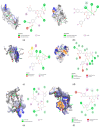Assessment of the Anti- Listeria Effect of Citrus limon Peel Extract In Silico, In Vitro, and in Fermented Cow Milk During Cold Storage
- PMID: 40002105
- PMCID: PMC11854709
- DOI: 10.3390/foods14040661
Assessment of the Anti- Listeria Effect of Citrus limon Peel Extract In Silico, In Vitro, and in Fermented Cow Milk During Cold Storage
Abstract
In this study, the antimicrobial effect of Citrus limon peel extract against Listeria monocytogenes was analyzed in silico, tested in vitro, and validated in fermented cow milk during cold storage. The in silico analysis revealed that 4,5-di-O-caffeoyquinic acid interacts with L. monocytogenes proteins involved in colonization and intracellular survival. The in vitro experiments demonstrated that the anti-Listeria activity of Citrus limon peel extract is primarily attributed to limonene and phenolic compounds. In fermented milk stored at 4 °C for 7 days, the addition of Citrus limon peel extract resulted in a 2 Log reduction of L. monocytogenes compared to the control. Using the Baranyi and Roberts model, a significant decrease in the maximum growth rate (-0.021 h-1) and the concentration of L. monocytogenes from 5.95 to 3.67 log CFU/mL was observed in fermented milk supplemented with a 2×MIC level of Citrus limon peel extract during storage at 4 °C. The findings from all three approaches highlighted that the inhibitory effect of Citrus limon peel extract against L. monocytogenes is primarily due to chlorogenic acid derivatives, especially 4,5-di-O-caffeoyquinic acid, and limonene. Beyond its antimicrobial properties, the supplementation of fermented milk with Citrus limon peel extract also enhances the milk antioxidant capacity and total organic acids content.
Keywords: Citrus limon peel extract; Listeria monocytogenes; docking visualization; fermented milk.
Conflict of interest statement
The authors declare no conflicts of interest.
Figures





Similar articles
-
Antimicrobial activity of acid-hydrolyzed Citrus unshiu peel extract in milk.J Dairy Sci. 2014;97(4):1955-60. doi: 10.3168/jds.2013-7390. Epub 2014 Feb 15. J Dairy Sci. 2014. PMID: 24534507
-
Citrus lemon essential oil: chemical composition, antioxidant and antimicrobial activities with its preservative effect against Listeria monocytogenes inoculated in minced beef meat.Lipids Health Dis. 2017 Aug 3;16(1):146. doi: 10.1186/s12944-017-0487-5. Lipids Health Dis. 2017. PMID: 28774297 Free PMC article.
-
Citrus limon Wastes from Part of the Eastern Cape Province in South Africa: Medicinal, Sustainable Agricultural, and Bio-Resource Potential.Molecules. 2024 Apr 8;29(7):1675. doi: 10.3390/molecules29071675. Molecules. 2024. PMID: 38611954 Free PMC article.
-
Citrus limon var. pompia Camarda var. nova: A Comprehensive Review of Its Botanical Characteristics, Traditional Uses, Phytochemical Profile, and Potential Health Benefits.Nutrients. 2024 Aug 8;16(16):2619. doi: 10.3390/nu16162619. Nutrients. 2024. PMID: 39203756 Free PMC article. Review.
-
Citrus limon (Lemon) Phenomenon-A Review of the Chemistry, Pharmacological Properties, Applications in the Modern Pharmaceutical, Food, and Cosmetics Industries, and Biotechnological Studies.Plants (Basel). 2020 Jan 17;9(1):119. doi: 10.3390/plants9010119. Plants (Basel). 2020. PMID: 31963590 Free PMC article. Review.
Cited by
-
Diversity of Lactiplantibacillus plantarum in Wild Fermented Food Niches.Foods. 2025 May 16;14(10):1765. doi: 10.3390/foods14101765. Foods. 2025. PMID: 40428544 Free PMC article.
References
Grants and funding
LinkOut - more resources
Full Text Sources
Molecular Biology Databases

